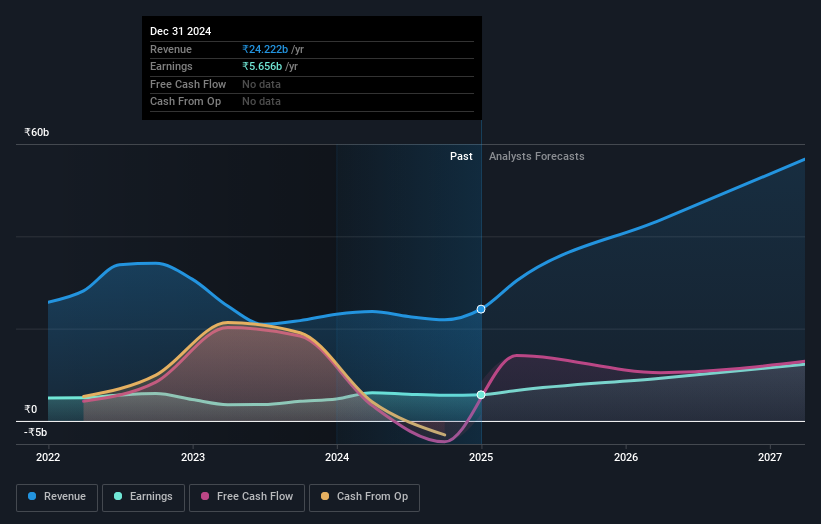- India
- /
- Aerospace & Defense
- /
- NSEI:BDL
Bharat Dynamics Limited (NSE:BDL) stock most popular amongst state or government who own 75%, while individual investors hold 13%

Key Insights
- Bharat Dynamics' significant state or government ownership suggests that the key decisions are influenced by shareholders from the larger public
- 75% of the company is held by a single shareholder (India)
- Institutional ownership in Bharat Dynamics is 12%
If you want to know who really controls Bharat Dynamics Limited (NSE:BDL), then you'll have to look at the makeup of its share registry. With 75% stake, state or government possess the maximum shares in the company. In other words, the group stands to gain the most (or lose the most) from their investment into the company.
Individual investors, on the other hand, account for 13% of the company's stockholders.
In the chart below, we zoom in on the different ownership groups of Bharat Dynamics.
See our latest analysis for Bharat Dynamics

What Does The Institutional Ownership Tell Us About Bharat Dynamics?
Institutions typically measure themselves against a benchmark when reporting to their own investors, so they often become more enthusiastic about a stock once it's included in a major index. We would expect most companies to have some institutions on the register, especially if they are growing.
We can see that Bharat Dynamics does have institutional investors; and they hold a good portion of the company's stock. This suggests some credibility amongst professional investors. But we can't rely on that fact alone since institutions make bad investments sometimes, just like everyone does. If multiple institutions change their view on a stock at the same time, you could see the share price drop fast. It's therefore worth looking at Bharat Dynamics' earnings history below. Of course, the future is what really matters.

Hedge funds don't have many shares in Bharat Dynamics. India is currently the company's largest shareholder with 75% of shares outstanding. This essentially means that they have extensive influence, if not outright control, over the future of the corporation. The second and third largest shareholders are HDFC Asset Management Company Limited and Life Insurance Corporation of India, Asset Management Arm, with an equal amount of shares to their name at 2.3%.
Researching institutional ownership is a good way to gauge and filter a stock's expected performance. The same can be achieved by studying analyst sentiments. Quite a few analysts cover the stock, so you could look into forecast growth quite easily.
Insider Ownership Of Bharat Dynamics
While the precise definition of an insider can be subjective, almost everyone considers board members to be insiders. The company management answer to the board and the latter should represent the interests of shareholders. Notably, sometimes top-level managers are on the board themselves.
I generally consider insider ownership to be a good thing. However, on some occasions it makes it more difficult for other shareholders to hold the board accountable for decisions.
We note our data does not show any board members holding shares, personally. It is unusual not to have at least some personal holdings by board members, so our data might be flawed. A good next step would be to check how much the CEO is paid.
General Public Ownership
The general public-- including retail investors -- own 13% stake in the company, and hence can't easily be ignored. This size of ownership, while considerable, may not be enough to change company policy if the decision is not in sync with other large shareholders.
Next Steps:
While it is well worth considering the different groups that own a company, there are other factors that are even more important. To that end, you should be aware of the 1 warning sign we've spotted with Bharat Dynamics .
If you are like me, you may want to think about whether this company will grow or shrink. Luckily, you can check this free report showing analyst forecasts for its future.
NB: Figures in this article are calculated using data from the last twelve months, which refer to the 12-month period ending on the last date of the month the financial statement is dated. This may not be consistent with full year annual report figures.
Valuation is complex, but we're here to simplify it.
Discover if Bharat Dynamics might be undervalued or overvalued with our detailed analysis, featuring fair value estimates, potential risks, dividends, insider trades, and its financial condition.
Access Free AnalysisHave feedback on this article? Concerned about the content? Get in touch with us directly. Alternatively, email editorial-team (at) simplywallst.com.
This article by Simply Wall St is general in nature. We provide commentary based on historical data and analyst forecasts only using an unbiased methodology and our articles are not intended to be financial advice. It does not constitute a recommendation to buy or sell any stock, and does not take account of your objectives, or your financial situation. We aim to bring you long-term focused analysis driven by fundamental data. Note that our analysis may not factor in the latest price-sensitive company announcements or qualitative material. Simply Wall St has no position in any stocks mentioned.
About NSEI:BDL
Bharat Dynamics
Manufactures and sells guided missiles and allied defence equipment in India.
Flawless balance sheet with high growth potential.
Market Insights
Community Narratives



